
Tool eases Grid monitoring
By
Kimberly Patch,
Technology Research NewsGrid computing takes advantage of Internet connections and unused resources connected to the Net -- like idle computers and vacant disk space -- to put together virtual computers powerful enough to handle compute-intensive problems like processing huge amounts of scientific data.
Although the concept of coordinating otherwise unused computers distributed around a worldwide network is relatively simple, the coordination takes a lot of effort. As Grid computing becomes more commonplace, researchers are developing tools that simplify the practice.
University of Melbourne researchers have produced a toolkit that makes it easier to see how a Grid job is going. The tool allows users to create a Web interface to a Grid computing testbed without having to do any programming.
The tool, dubbed Gridscape, includes a template that allows users to plug in information like a testbed name, logo, information about the computers being used in the testbed, and a geographical map, said Rajkumar Buyya, a lecturer of computer science and software engineering at the University of Melbourne in Australia.
Most simply, Gridscape provides users with a holistic view of a testbed that shows user application jobs running on different Grid nodes, said Buyya. The tool can also be used to search for resources like computers that have certain attributes, to check the attributes of a given resource, or to check which resources are currently on-line, he said. "The status of Grid resources is displayed on a geographic map [of] the testbed [that] can be queried further for detailed information."
The tool dynamically creates Web content using Java JSP, Servlets and interactive client side JavaScript. "Once the user has finished customizing [the] portal, the changes may be viewed on-line immediately," said Buyya.
To create the tool, the researchers began with another Grid tool: the information services components of the Globus Grid toolkit. "It provides us with a standard interface for gathering Grid resource information," said Buyya. "Without those protocols a generalized tool like this really would be difficult to produce," he said.
The researchers' aim was to make a simple, widely accessible tool that would enable more rapid development of Grid testbed portals, said Buyya. Existing portal development kits provide programming interfaces to a lower-level Grid framework that requires an a significant amount of programming effort, he said. Gridscape makes it possible to rapidly develop testbed portals without programming, instead offering "a more generic solution," he said.
The Web-based interface is interactive, dynamic and widely accessible, and the client-side portion of the tool is light-weight, meaning it does not take a lot of computing resources, said Buyya. The drawback to the tool is it may not be specific enough for some testbed requirements, he said.
In general, Grid computing is allowing scientists to tackle very large problems that require large amounts of computer resources, said Buyya. "Distributed computing is... allowing us to deal with data and compute intensive problems which we previously thought were unfeasible," he said.
When this type of computing is further developed, "Grid computing power [will] become analogous to our current electrical power grids," said Buyya. People will be able to elect to consume computing power as a utility, as they do with electricity, gas and water, he said.
The first version of Gridscape is in regular use, and the researchers are getting ready to release an open source version, according to Buyya.
The researchers also have plans to integrate Gridscape with their G-monitor Web portal tool. G-monitor allows users to monitor, control and steer the execution of Grid applications, said Buyya.
They are also working on extending Gridscape to support handheld devices and mobile phones, he said.
Buyya's research colleague was Hussein Gibbons. The research was funded by the University of Melbourne, the Victorian Partnership for Advanced Computing, and Sun Microsystems.
Timeline: Now
Funding: Corporate, University
TRN Categories: Distributed Computing
Story Type: News
Related Elements: Technical paper, "Gridscape: A Tool for the Creation of Interactive and Dynamic Grid Testbed Web Portals," Research Report from the GRIDS Lab at The University of Melbourne, July 2003, posted in the Computing Research Repository (CoRR) at arxiv.org/abs/cs.DC/0307052
Advertisements:
December 31, 2003/January 7, 2004
Page One
Bots, humans play together
Light frozen in place
Gel gains life-like motion
Tool eases Grid monitoring
Briefs:
Biochip holds millions of vessels
Inside-out images secure screens
Colors expand neural net
Micro fuel cell runs cool
Electroplating boosts solar cells
Shape key to strong sensors
News:
Research News Roundup
Research Watch blog
Features:
View from the High Ground Q&A
How It Works
RSS Feeds:
News
Ad links:
Buy an ad link
| Advertisements:
|
 |
Ad links: Clear History
Buy an ad link
|
TRN
Newswire and Headline Feeds for Web sites
|
© Copyright Technology Research News, LLC 2000-2006. All rights reserved.